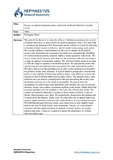| dc.contributor.author | Pontiggia, Dario | |
| dc.date.accessioned | 2015-12-16T10:35:13Z | |
| dc.date.available | 2015-12-16T10:35:13Z | |
| dc.date.issued | 2009 | |
| dc.identifier.uri | http://hdl.handle.net/11728/6661 | |
| dc.description.abstract | The aim of this thesis is to study the effects of inflation persistence due to rule-of-thumb behaviour by price setters on optimal monetary policy. We start with a canonical log-linearised New Keynesian model, which we extend by allowing a fraction of price setters to follow a rule-of-thumb when setting a new price. We consider different specifications for the rule-of-thumb. In all models, steady-state distortions are assumed to be small so to guarantee the feasibility of optimal monetary policy analysis within a linear-quadratic framework. We derive utility-based objective functions for the monetary authority and analyse a range of optimal commitment policies. We perform welfare analysis in order to rank the range of optimal commitment policies. We analytically derive the optimal steady-state inflation rates associated with each commitment policy. We show that rule-of-thumb behaviour by price setters generates an incentive for positive steady-state inflation. A type of timeless perspective commitment policy is also capable of delivering positive steady-state inflation, even in the absence of rule-of-thumb behaviour by price setters. The optimal steady-state inflation rates are directly proportional to the gap measuring the steady-state distortions and turn out to be small in magnitude. We depart from the assumption of small steady-state distortions and consider the case of a largely distorted steady state within a nonlinear medium-scale model, which adds both nominal rigidities and real rigidities to the basic New Keynesian model. We extend the model by allowing a fraction of price setters to follow a rule-of-thumb when posting a new price. We numerically characterise the optimal rate of inflation in the Ramsey steady state. We find that rule-of-thumb behaviour implies optimal positive inflation only in the absence of transactional frictions. We find that the gap reflecting steady-state distortions is only slightly larger than in the case of small steady-state distortions. Finally, we study Ramsey dynamics and the implementation of optimal monetary policy via simple interest-rate rules, which we expand to explore the importance of welfare relevant output gaps. | en_UK |
| dc.language.iso | en | en_UK |
| dc.rights.uri | http://creativecommons.org/licenses/by-nc-nd/4.0/ | en_UK |
| dc.source.uri | http://theses.gla.ac.uk/id/eprint/1399 | en_UK |
| dc.subject | Research Subject Categories::SOCIAL SCIENCES::Business and economics | en_UK |
| dc.subject | Optimal monetary policy | en_UK |
| dc.title | Essays on optimal monetary policy under rule-of-thumb behaviour by price setters | en_UK |
| dc.type | Thesis | en_UK |


